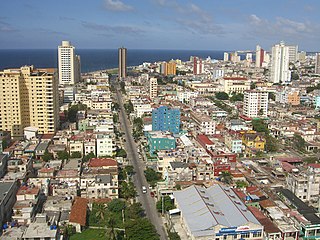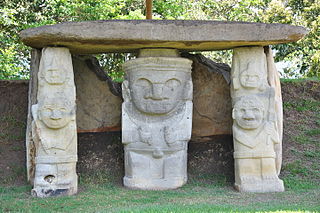Contents
This is list of archives in Cuba. [1]
This is list of archives in Cuba. [1]

Havana is the capital and largest city of Cuba. The heart of the La Habana Province, Havana is the country's main port and commercial center. It is the most populous city, the largest by area, and the second largest metropolitan area in the Caribbean region. The population in 2012 was 2,154,454 inhabitants, and its area is 728.26 km2 (281.18 sq mi) for the capital city side and 8,475.57 km2 for the metropolitan zone.

The Basílica Menor of San Francisco de Asís is a Catholic minor basilica and Franciscan convent in the district of Old Havana, Cuba. Its construction began in 1548 and lasted until 1591, although it was inaugurated in 1575, it was badly damaged by storms in 1680 and 1692, and by a hurricane that broke down its tower in 1694. Started in its current form in 1716, it was completely completed almost 200 years later, with a series of structural reforms from 1731 to 1738.

José Antonio Saco was a statesman, deputy to the Spanish Cortes, writer, social critic, publicist, essayist, anthropologist, historian, and one of the most notable Cuban figures from the nineteenth century.

The National Historical Archive of Spain is based in Serrano Street in Madrid. It was founded in the nineteenth century when it shared a building with the Real Academía de la Historia.
The following is a timeline of the history of Havana, Cuba.
Julio Mario Luqui-Lagleyze is an Argentine historian. Born in Buenos Aires in 1959 received a degree in History in 1982. He specializes in Hispano-American Military and Naval History and Military Museology. He is currently studying for his PhD in History at the Universidad Católica Argentina.
The Archivo Nacional de la República de Cuba is the national archive of Cuba. Founded in 1840, it is located in Havana on Calle Compostela. Directors have included Vidal Morales y Morales and Joaquín Llaverías Martínez.
The following is a timeline of the history of the city of Santiago, Cuba.
The following is a timeline of the history of the city of Camagüey, Cuba.
The following is a timeline of the history of the city of Matanzas, Cuba.
The following is a timeline of the history of the city of Cienfuegos, Cuba.
The following is a timeline of the history of the city of Holguín, Cuba.
The Instituto de Historia de Cuba in Havana, Cuba, is a research institute, archive, and library of late 19th and 20th century Cuban history. It was established in 1987 under the Central Committee of the Communist Party of Cuba. It is located in the Palacio de Aldama near the Parque de la Fraternidad in Havana. Among its collections are records related to Sergio Carbó y Morera and Ramón Grau. Staff of the institute have included Oscar Zanetti, among others. According to its website, research focuses on topics such as Cuban economics, politics, society, regional history, and international relations.
The following is a timeline of the history of the city of Las Palmas, Canary Islands, Spain.

Campuzano-Polanco was a prominent family from the Captaincy General of Santo Domingo with origins in Santiago de los Caballeros. During the colonial era of the Hispaniola, their members and descendants went on to occupy high political, military, and ecclesiastical positions, locally and outside the Island, as well as in the metropolis of Spain. Their merits span from the beginning until the end of the colony.

Juan Friede Alter was a Ukrainian-Colombian historian of Jewish descent who is recognised as one of the most important writers about Colombian history, the Spanish conquests and a proponent of indigenism; the defense of the rights and descriptions of the oppression of indigenous people.
The following is a timeline of the history of the municipality of Bayamón, Puerto Rico.